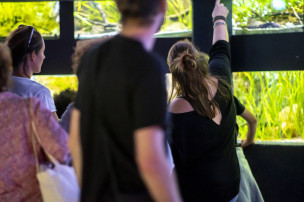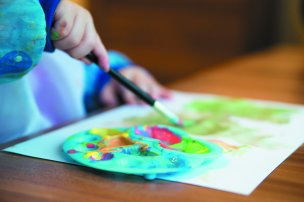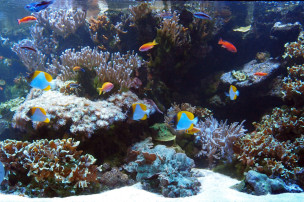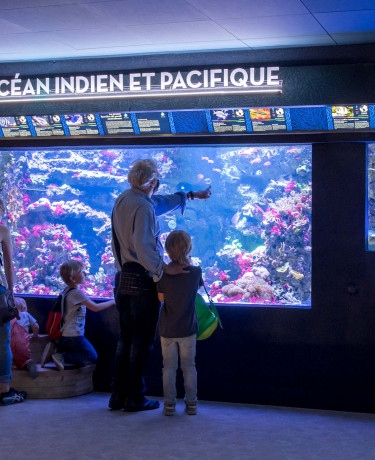
Living collections
84 aquariums with capacities of 50 to 16,000 litres present a voyage into continental tropical waters !
Welcome !
In an incomparable atmosphere, come and "dive through the coral reefs", "sail down" the rivers of Amazonia and Asia, "observe" the depths of the great African lakes and grottoes of Central America, or "wander" through a mangrove.
Piranhas, sea horses, rays, albino alligators, electric fish, clownfish, surgeonfish, these are just a few of the stars who visitors will recognise. But they’re not the only ones!
Since 1931, the Tropical Aquarium has been home to 550 different freshwater and saltwater fish, corals, marine organisms, turtles and crocodilians, displayed in tanks and vivariums that recreate the many different environments.
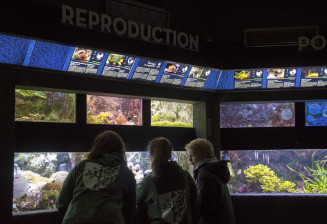
The result is a series of tableaux vivants, enriched and monitored daily by the team of aquariologists. They will leave you amazed at the incredible beauty and biodiversity of nature as you admire a multitude of astonishing aquatic animals, observe their relationships and behaviour, come to understand how these environments work, and realize the urgent need to preserve them.
The new tanks in the Grand Marina section
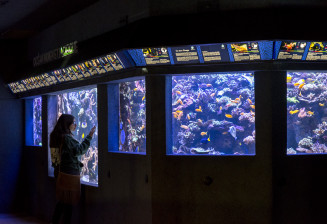
Dedicated to tropical marine ecosystems, the Grand Marina has been extensively renovated for the very first time. The renovation provided the opportunity to modernise the technical aspects of this section, correcting watertightness and simplifying the seawater supply network into the tanks.
The seawater is produced on-site, and the Tropical Aquarium is in fact the leading seawater producer in Paris!
In addition to this, LED lighting has been installed, which is more economical and provides a more efficient response to the animals’ needs, particularly the coral. The Tropical Aquarium chose to recreate tanks identical to the previous ones, to preserve the general atmosphere of this heritage site, over 90 years old.
Reconstruction of the coral décors
After receiving new aquariums, there is a four-week waiting period while the water matures to ensure that the ecosystems are ready to welcome the animals. Particular attention was paid to setting up the coral, which is a key element in the ecosystems on display.
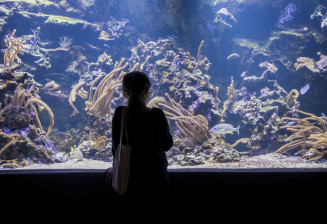
For several years now, the Aquarium has been working on a research project in partnership with the Muséum National d’Histoire Naturelle. Many coral species have been able to increase their numbers as a result of the aquariologists’ expertise. The operation has enabled the reproduction of several species that are endangered in their natural environment. Cuttings from over 1500 plants representing 37 different coral species will develop and form new décors for the aquariums. It will take several years, however, for the coral to reach maturity and regain its full splendour.
Rethinking the living collections plan
To optimise the well-being of Aquarium residents during the construction period, a large number of them had to be sent out to the French aquarium network. The renovation provided an opportunity to look for new specimens to create new ecosystems: African lakes, Asian rivers, the mangroves and reefs of New Caledonia. The aquariologists opted for species of a size compatible with aquarium volumes, giving priority to fish and invertebrates whose reproduction has been mastered, which is largely the case for freshwater species. For marine species, the Tropical Aquarium has benefitted from the initiatives of other French aquariums which, as part of the Union des Conservateurs d’Aquarium, are working on mastering the reproduction of new species.
Did you know?
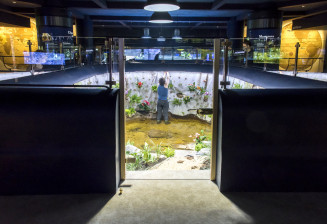
The well-being of the animals is essential for the Aquarium and filling the new tanks with water was a long-term undertaking. The tanks were first rinsed off with freshwater to eliminate the harmful particles remaining in the concrete, they were then rinsed in seawater and finally filled. The water is made at the Palais: a mixture of very pure reverse-osmosized water and mineral salts recreating the composition of the original environment. Next, the water must be left to mature, a procedure that lasts one month. This is the time it takes to generate enough bacteria to eliminate excrement from the future fish.
The return of albino alligators in a spectacular pit
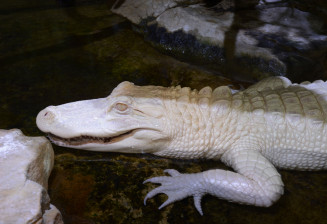
Since February 2014, the Aquarium has welcomed some extremely rare specimens: two albino alligators, Laury and Dundy. What makes these animals so rare is the fact that, according to the laws of genetics, each of the two parents must carry the genes responsible for albinism. Albinos exist throughout the animal kingdom. They are characterised by a very pale skin (no melanin in the melanocytes), depigmentation of the hair or exoskeletons and blue to grey irises with a red-looking reflection.
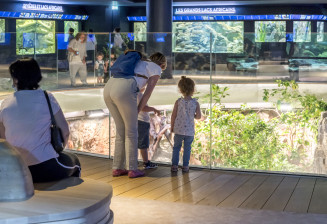
After a stay at Biotropica during the construction work, the Palais’s albino alligators have now returned and are currently enjoying a spectacular pit surrounded by a transparent wall accessible to all visitors. The pit is also equipped with special lighting that provides the plants with the quality and quantity of light they need for correct growth and, through a system reproducing the daily cycle, recreates the animals’ biological rhythm in their natural environment.
Did you know?
The Tropical Aquarium at the Porte Dorée tells the story of one of the finest crocodile pits in Europe. This pit was created in 1934 and welcomed its first crocodiles in a décor that was unprecedented in an animal park. In 1948, Théodore Monod, a scientist, naturalist and explorer for the Muséum National d’Histoire Naturelle, sent a new group of Nile crocodiles (Crocodylus niloticus) from Dakar, thus sparking the legend of the “crocodile pit” in the imagination of visitors. The very last of these crocodiles, who arrived in 1948 as adults, lived until 2008. For 60 years, several generations of visitors have faithfully returned over and over again to see these emblematic residents of the Tropical Aquarium.
